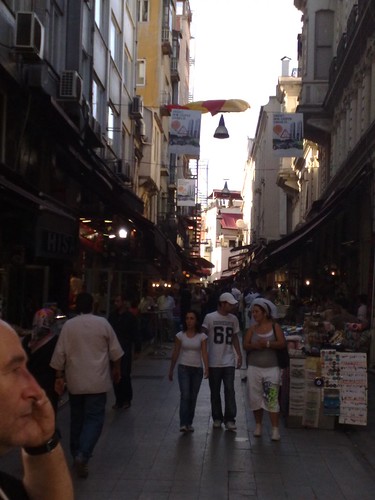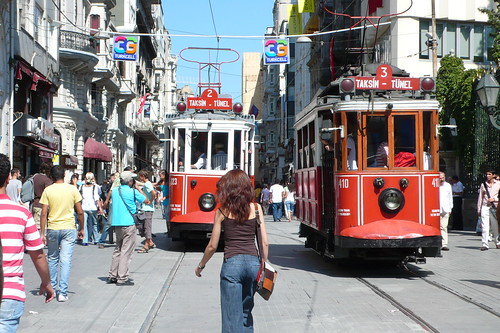The political capital of Turkey is Ankara, but Istanbul focused tourism. The Turkish capital has one foot in each continent. Mosques are basilicas, stadiums and arenas, women veiled contempt and others. Contrasts of a millenarian passion.

Photography by fsse8info
Here is a strait that separates the city on two continents, there are boats everywhere, there is strong around a good chunk of the city, houses that are accessed by boat, a modern town in which the first world power projection and an older one that glitters historical cost. Here is a bazaar in which people lose sanity. A bazaar that involves entry just, surrender to lawlessness.
Because everything is there indeed a great loss of control, shouting vendors, tourists haggle, no fights, laughter, discussions. This is one of the oldest and largest markets in the world (45 square meters). Work there more than 20 000 people, mostly in one of the 3,600 stores spread over 64 labyrinthine streets that lead to 22 different outputs. It is impossible not to miss: spend, per day, more than 250 000 individuals.
In this bazaar, in fact, bargaining is pure fiction. Merchants from a price and end up giving unusual at an agreed price, with a false posture of resignation. Outside, in the vicinity, the secret is. A box of spice vendors say costs 30 YTL (and then sold to 15) in the surrounding streets out 10 (and the price is not negotiable). But visit the place is worth it. It may even be a shock therapy. The origins of the Grand Bazaar dates back to the time of Mehmed II in 1455 when his palace built near the old bazaar (Eski Bedesten). It sells everything from sweaters, lamps, spices, local garments, fabrics, rugs, antiques, perfumes, handbags, leather … etc. There are nearly one hundred varieties of different products. The essence of the Turkish trade to serve the tourist is a dream.
Here are drivers out of control, men playing backgammon for hours (local tradition), woman scorned and women covered from head to toe. There are night clubs in the street outside, local music, where people smoke hookah scented snuff and dances, and others, also outdoors, more Europeanized, with narrow view, beneath a bridge with an entry of 50 YTL (about 130 pesos). Here are stadiums that seem arenas and hotels with shopping renewed incorporated. Houses also very small, poor neighborhoods and sectors that seem to open fields.
Here one can walk along the street could be considered the most fearsome in the world, with cats, trash, and dark eyes, go to another scenic view with young people dancing, pubs, colored lights, bars and restaurants on two floors of passage . It happens every night in Taksim, a colorful area of town where, at sunset, drinking Turkish pace through the streets surrounding the famous Istiklal pedestrian, two kilometers. Istiklal symbolizes globalization and claims the western side of town. Fighting a price any business of their loud blocks could wake up in the junior salesman. The main brands are distributed in local textiles in two to three floors and there are no offers because everything is expensive.

Photography by Augapfel
Here are dozens of mosques, but there is one, the Blue Mosque, unique. It was built in the early seventeenth century and is 23 meters in diameter, plus 43 high. He has over 20 000 blue tiles adorning the dome and the top (hence the name) and over 200 windows. The verses of the Qur’an distributed in different places round the interior design. In the Blue Mosque, Turkish religious orthodoxy swept daytime Taksim concepts: women must cover their head to enter and shoulders have to carry concealed. No one can enter the place with shoes.
Synthesis of permanent contrast in every corner, just opposite the imposing Blue Mosque, is the Basilica of St. Sophia, an ancient Christian cathedral of Constantinople, which became a mosque in 1453 and a museum in 1935. Another superb book, favorite child of Byzantine art.
Here is a spice bazaar with more than ninety shops, a promenade endless restaurants top corner too close to the Cañitas, train stations too similar to the Argentine (except for the timeliness of service), dozens of avenues boulevards in between, dozens of cut which is just over a car, endless highways and two bridges that separate Europe from Asia. There is a palace called Topkapi, which is a delusion of ostentation. It was the administrative center of the Ottoman Empire from 1465 to 1853: they lived there for more than four thousand people. It consists of four small buildings and courtyards, with different purposes. The first was public access, the second major conventions were held (there are ten wards who officiated at the time, as imperial kitchens), the third could only enter the dignitaries and the fourth was the sultan of the day relaxing. The view of this sector, obviously, gives the Bosphorus. The total area of the complex is 700 thousand square meters, nearly half the length of Monaco.

Photography by jefield
Here is a tank (the tank Yerebatan) which, in turn, was able to accommodate 90 thousand meters cubic, there are castles, businesses that offer the famous Turkish baths (they cost about 50 euros) and a majestic harbor of the most congested in the world (130 ships a day, not counting local traffic). Here, in short, is everything. Because that is Istanbul endless options, permanent contrast, intensity. A cultural and ethnic melting pot. Even in the Asian side, the less touristy, has its social and aesthetic disproportion: Üsküdar and Kadiköy, the two largest neighborhoods, without going further, have very humble sectors while residential areas (such as Fashion).
Napoleon Bonaparte once said: «If the earth were a single state, would be the capital Istanbul.» It is no accident. Apart from his ever-growing population mass (one of the major capitals of Europe, with more than 14.5 million), distinguishes the simple fact of being one of the most historic cities.
No one can ever accurately portray this place unending loyalty. All the contradictions political, religious, architectural and structural discovered are part of local identity. You can not expect less from a city that, in addition to being divided into two continents by a single narrow (the Bosphorus), is also divided in its sector in Europe by a beautiful estuary (Golden Horn).
Many cities in one. That is Istanbul.
Leave a Reply
You must be logged in to post a comment.
Recent Comments